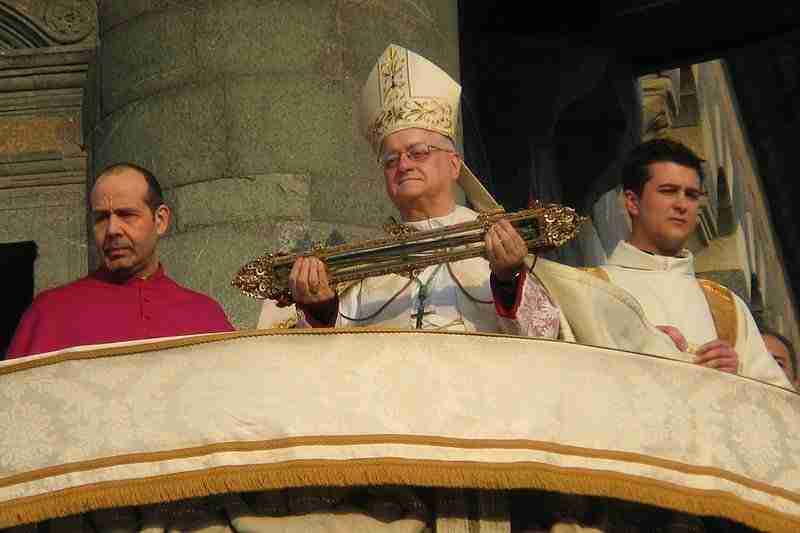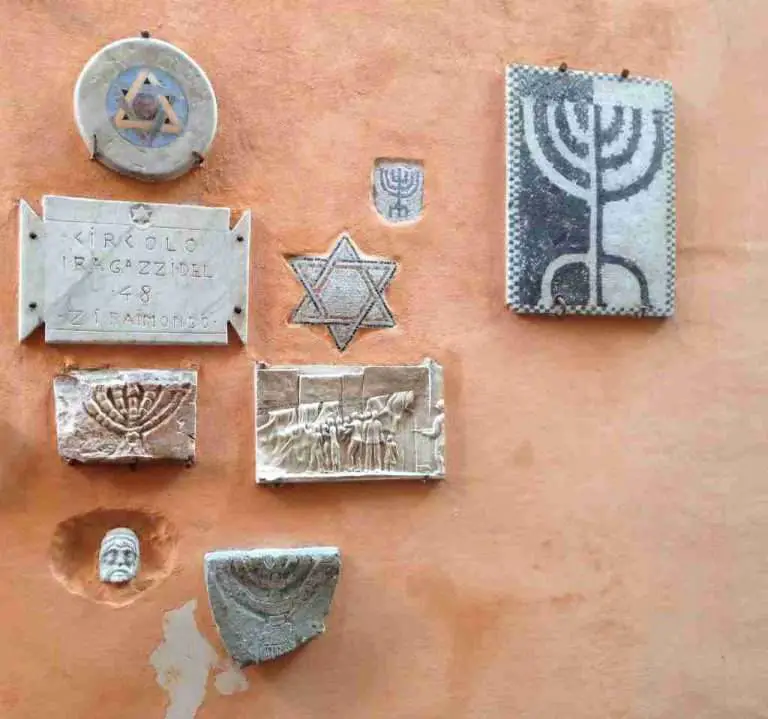
No matter if you’re a devout Catholic or a curious non-believer, you should make a point to check out a few of Italy’s unusual religious relics.
More than 2,000 years of Christianity have produced numerous fascinating stories – some gruesome, some inspirational, some a little of both. Indeed, for every Biblical tale and saintly life, there is, most likely, at least one precious relic housed in Rome, the Vatican, or in one of Italy’s thousands of churches.
The Shroud of Turin in Turin

The Shroud of Turin is one of Italy’s most famous relics, housed in the Cathedral of Turin (Duomo di Torino) in the Piemonte region. The Shroud is a linen cloth that bears “the image of a man who appears to have been physically hurt in a manner consistent with crucifixion.” In short, the image on the Shroud bears a striking resemblance to the collectively agreed upon image of Jesus Christ and is thought to be Christ’s burial shroud – thus, the relic’s significance among Christians.
View a full-length, interactive image of the Shroud of Turin.
As with all religious relics, the Shroud’s authenticity has been doubted. Even the Catholic Church has yet to formally endorse the Shroud. And a recent scientific study confirms the shroud as a relic of the Middle Ages (i.e., NOT 2,000 years old). Nevertheless, this sacred relic (called Santa Sindone in Italian) is well-protected by the Brotherhood of the Holy Shroud.
Because of the Shroud’s delicate nature, it is rarely on display. Only the Pope can decide when the Shroud is allowed to go on display and there is no official schedule for this.
The last time the Shroud was on view was 2015. For more information, visit the official Shroud of Turin website.
The Blood of San Gennaro in Naples

It’s hardly surprising that a hot-blooded place like Naples would have a relic made of blood (see photo above).
Each year, the city of Naples awaits the liquefaction of the blood of Saint Januarius (San Gennaro), which is stored in an ampoule in a reliquary in the Naples Cathedral.
An early saint of the church, having been beheaded during Emperor Diocletian’s anti-Christian raids in the 4th century, San Gennaro is the patron saint of Naples. The city celebrates his feast day each year on 19 September.
San Gennaro’s blood is said to liquefy on at least one of these dates during the year: the first Sunday in May; the saint’s feast day on 19 September; and on 16 December. The liquefying of San Gennaro’s blood is thought to signify a miracle and helps protect Naples from calamities, such as the eruption of Mount Vesuvius.
The Holy Foreskin in Calcata (Lazio)

(Currently Missing)
David Farley’s book An Irreverent Curiosity: In Search of the Church’s Strangest Relic in Italy’s Oddest Town was one of the inspirations for this post.
In his book, Farley writes about the hilltop village of Calcata, the former home of the Holy Foreskin, which was housed here for centuries until its disappearance in 1983.
Farley has devoted himself to this subject, so you’d do well to read his book to learn about the relic and Calcata, which is known as a “village of freaks.” But here’s an interesting tidbit: apparently Saint Catherine of Siena wore the Holy Foreskin as a ring. Now that’s some devotion.
Tongue and Jaw of Saint Anthony in Padua


Saint Anthony is one of the most revered saints both inside and outside of Italy. His basilica in Padua, a multi-domed architectural jewel replete with numerous chapels and ornamentation, holds several relics of the saint’s body.
The most intact of these relics are Saint Anthony’s jaw and tongue, both housed in ornate golden reliquaries. These relics highlight Saint Anthony’s skill as a speaker, such as his sermon to the fishes.
Visit the official Sant’Antonio di Padova website for more details.
Tunics Worn by Saint Francis in Assisi

Saint Francis, Patron Saint of Italy, earned his sainthood thanks to his life of shunning earthly treasures in favor of a life of solitude, devotion, and prayer. His simple tunics, made of rough cloth (like burlap), inspired the similar brown cloaks worn by Franciscan monks today.
Symbols of his voluntary poverty, Saint Francis’s 13th-century tunics are on display in the crypt under the main altar of his basilica in Assisi.
Learn more about Frate Francesco from the official Basilica of Saint Francis of Assisi website.
Mary’s Holy Belt in Prato (Tuscany)

The Virgin Mary didn’t leave behind a piece of her body for future Christians to revere. But she did leave behind a belt.
The story goes that Mary gave this sacred accessory to Apostle Thomas as she ascended to heaven. The Prato Cathedral acquired the relic in the 14C and has kept it in a precious silver reliquary ever since. In addition to a special chapel, which was purpose-built to house the relic, the church commissioned artists Michelozzo and Donatello to build an exterior pulpit. It is here that the relic is ceremoniously displayed to crowds below.
Unlike the delicate Shroud of Turin, the Sacra Cintola is made of a more durable material—green wool—a fact that makes it easier to display. The belt goes on display five times a year: Christmas, Easter, May 1, August 15, and September 8.
Prato is located in Tuscany, just north of Florence.
Religious Relics in Rome
Being the center of the Christian universe, Rome has the most holy relics per square kilometer (or mile) of any other city in Italy. And here you will find some wonderfully odd ones, including:
- Saint John’s severed head in the church of San Silvestro in Capite (also the National Church of Great Britain in Rome)
- Saint Valentine’s head in the Santa Maria in Cosmedin (the rest of the body is in Terni, Umbria)
- The head of Saint Agnes, located in a side chapel of Sant’Agnese in Agone (the huge church, designed by Borromini, that fronts Piazza Navona)
- The “doubting finger” of Saint Thomas (in Santa Croce in Gerusalemme)
- Papal innards in the church of SS. Vincenzo e Anastasio near the Trevi Fountain
- Saint Francis Xavier’s forearm in the church of the Gesù (the rest of the body is in Goa, India)
- The Santo Bambino in Santa Maria Aracoeli
More Relic Resources
I’ve barely even scratched the surface of all of the unusual relics one can find in Italy. So here are a few more resources.
My friend The Catholic Traveler provides a more thorough history on Catholic relics in Italy and beyond. His photos of incorruptible bodies are a must-see.
Another Catholic website, The Catholic Travel Guide, has an extensive list of relics in Italy. Another extensive list of relics in Rome is available from the Roman Churches Fandom website.
Last updated on September 18th, 2023Post first published on November 12, 2009






